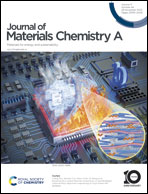Self-organized defect-rich RuMOx epitaxial layers (M = Mn, Fe, Co, Ni, Cu) for catalytic applications†
Abstract
Catalysts with epitaxially-grown metal oxide on the substrate have wide catalytic applications. However, manipulations of the surface reactivity remain challenging due to the lack of a simple strategy to engineer the morphology, surface atomic composition, and defect distribution of the epitaxial layer, limiting performance improvement. Here, we report a heterometal dopant-assisted epitaxial growth phenomenon for engineering the surface structure and reactivity of metal-oxide epitaxy. Our method focuses on the regulation of the lattice parameters of the epitaxy by heterometal doping. This approach can reduce the misfit and thereby stabilize the metal-oxide/substrate interface, resulting in epitaxial growth with a high aspect ratio, tunable surface atomic composition, and abundant defects. As a proof of concept, the doping effect of 3d transition metals (M = Mn, Fe, Co, Ni, Cu) on the epitaxial growth mechanism of RuOx on a rutile TiO2 substrate and their catalytic performance were investigated in the present study. It was found that simple co-impregnation of Ru and M nitrate solutions and subsequent calcination under an air atmosphere resulted in a unique set of epitaxial layers consisting of Ru and M oxides with atom thickness (RuMOx-ELs). These were grown by Frank–van der Merwe or Stranski–Krastanov growth modes. On the other hand, when only Ru nitrate was used for the catalyst preparation, the RuOx epitaxial nanoparticles were grown by the Volmer–Weber growth mode. The heterometal doping plays a pivotal role in tuning the lattice parameters of the epitaxy to reduce the misfit at the interface, driving the self-organization of the novel RuMOx-ELs even on a powder substrate without any special procedures. The RuMOx-ELs feature a high aspect ratio, and selectively exposed specific facets with abundant Ru–Olatt/Ovac–M local structures as the reactive sites. The surface concentration of Ru–Olatt/Ovac–M local structures and their reactivity depends on the kind of M; therefore, heterometal dopant-assisted epitaxial growth can be utilized to optimize the surface structure of the epitaxy for the target reaction. Its significance was proven by the fact that we have succeeded in creating the highest activity toward a low-temperature CO oxidation among the Ru-based catalysts reported in the literature.

- This article is part of the themed collection: 2023 Journal of Materials Chemistry A HOT Papers


 Please wait while we load your content...
Please wait while we load your content...